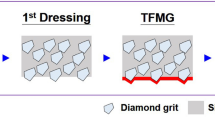Abstract
High-speed dicing tests were conducted for silicon wafers using developed ultrathin electroplated diamond blades with metal bond. Chipping and kerf widths of 1.5 and 28 μm, respectively, are achieved by the developed ultrathin diamond blades. The calculated maximum undeformed chip thickness varied from 9.6 to 25.5 nm for various high-speed dicing conditions. The variation tendency between experimental chip width induced by three diamond blades and corresponding calculated maximum undeformed chip thickness is consistent. Scanning electron microscopy showed that the microstructure of diamond dicing blades significantly affected the chip width.
Similar content being viewed by others
References
Ganesh VP, Lee C (2006) Overview and emerging challenges in mechanical dicing of silicon wafers. 8th Electronics Packaging Technology Conference, Singapore, 15–21
Thompson DL, Haubrich GJ (2003) Implantable medical device incorporating miniaturized circuit model. US Patent 6567703
Sun JN, Gidley DW, Dull TL, Frieze WE, Yee AF, Ryan ET, Lin S, Wetzel J (2001) Probing diffusion barrier integrity on porous silica low-k thin films using positron annihilation lifetime spectroscopy. J Appl Phys 89(9):5138–5144
Hye KJ, Lee HB, Tsukasa M, Jung E, Yun JH, Lee JM, Choi GH, Choi S, Chung C (2011) Formation of highly reliable Cu/low-k interconnects by using CVD Co barrier in dual damascene structures. IEEE International Reliability Physics Symposium (IRPS 2011), Monterey, CA, USA, 10-14 April, 3E.2
Hussein MA, He J (2005) Materials' impact on interconnect process technology and reliability. IEEE Trans Semicond Manuf 18(1):69–85
Rajen C (2009) 3D integration technologies—an overview. In: Lu D, Wong CP (eds) Materials for advanced packaging. Springer, New York, pp 1–50
Frank N, Adit D, Fredrik F, Niclas R, Martin L, Michael P, Fabian Z, Jörn L, Göran S (2009) Wafer bonding with nano-imprint resists as sacrificial adhesive for fabrication of silicon-on-integrated-circuit (SOIC) wafers in 3D integration of MEMS and ICs. Sens Actuators A Phys 154(1):180–186
Koester SJ, Young AM, Yu RR, Purushothaman S, Chen KN, La TDCJ, Rana N, Shi L, Wordeman MR, Sprogis EJ (2008) Wafer-level 3D integration technology. IBM J Res Dev 52(6):583–597
Luo SY, Wang ZW (2008) Studies of chipping mechanisms for dicing silicon wafers. Int J Adv Manuf Technol 35(11–12):1206–1218
Song C, Zhang Z (2003) Dicing technology in super-thin wafer for IC. Fifth international conference on electronic packaging technology, Shanghai, China, 28-30 October, 130–132
Toshiharu M, Ichiro I, Isao Y (1999) Blade wear and wafer chipping in dicing processes. Trans Jpn Soc Mech Eng C 65:801–806
Kim SC, Lee ES, Kim NH, Jeong HD (2007) Machining characteristics on the ultra-precision dicing of silicon wafer. Int J Adv Manuf Technol 33(7–8):662–667
Shi KW, Yow KY, Khoo R, Lo C (2009) Wafer dicing process optimization and characterization for C90 low-k wafer technology. Proceedings of the electronic packaging technology conference, Singapore, 9-11 December, 889-892
Zhang ZY, Huo FW, Wu YQ, Huang H (2011) Grinding of silicon wafers using an ultrafine diamond wheel of a hybrid bond material. Int J Mach Tools Manuf 51(1):18–24
Zhang ZY, Wu YQ, Guo DM, Huang H (2011) Phase transformation of single crystal silicon induced by grinding with ultrafine diamond grits. Scripta Mater 64(2):177–180
Malkin S, Guo CS (2008) Grinding technology: theory and applications of machining with abrasives, 2nd edn. Industrial Press, New York, pp 54–79
Xu LM, Shen B, Shih AJ (2006) Vitreous bond silicon carbide wheel for grinding of silicon nitride. Int J Mach Tools Manuf 46(6):631–639
Zhang ZY, Song YX, Xu CG, Guo DM (2012) A novel model for undeformed nanometer chips of soft-brittle HgCdTe films induced by ultrafine diamond grits. Scripta Mater 67(2):197–200
Zhang ZY, Xu CG, Zhang XZ, Guo DM (2012) Mechanical characteristics of nanocrystalline layers containing nanotwins induced by nanogrinding of soft-brittle CdZnTe single crystals. Scripta Mater 67(4):392–395
Zhang ZY, Song YX, Huo FW, Guo DM (2012) Nanoscale material removal mechanism of soft-brittle HgCdTe single crystals under nanogrinding by ultrafine diamond grits. Tribol Lett 46(1):95–100
Zhou HX, Wang CM, Zhao DJ, Zhao HH (2012) Nanogrinding of soft-brittle monocrystalline mercury cadmium telluride using a ceramic bond ultrafine diamond grinding wheel. Int J Adv Manuf Technol 60(9–12):933–938
Author information
Authors and Affiliations
Corresponding author
Rights and permissions
About this article
Cite this article
Zhou, H., Qiu, S., Huo, Y. et al. High-speed dicing of silicon wafers conducted using ultrathin blades. Int J Adv Manuf Technol 66, 947–953 (2013). https://doi.org/10.1007/s00170-012-4379-6
Received:
Accepted:
Published:
Issue Date:
DOI: https://doi.org/10.1007/s00170-012-4379-6




